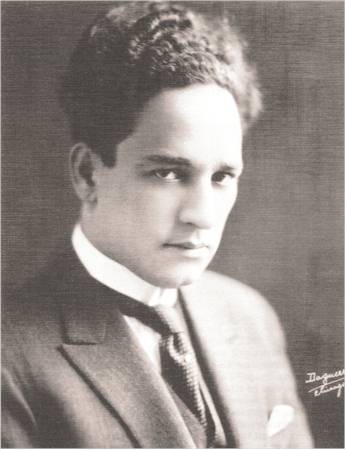Antonio Cortis
12 August 1891 – 2 April 1952 Valencia

In RA format
In RA format
| Antonio Cortis sings El tropezón
|
| This song was composed by Cortis himself, together with tenor
colleague José Mojica. |
In RA format
Antonio Cortis – real name: Antonio Montón Corts – was, I've no idea why, born aboard a ship, that's why it
doesn't make terribly much sense to give, what you'll read in many sources, Dénia as his birthplace: that's just where
his birth was officially registered since it was where his family lived, but they soon moved to Valencia, then to Madrid.
He studied music at the Real Conservatorio in Madrid early on, from age 8: violin and composition; when his mother (the father
had died) moved to Barcelona, he continued his studies there, and now added also voice. He started singing in the chorus of the
Teatre del Liceu in 1910, and it seems that he also got some tiny solo parts to sing there from 1912. In any case, from 1915, he
was a soloist at the Real in Madrid, singing comprimario roles only.
Not for long: in 1916, he was hired by the Teatro Español in Barcelona as a first tenor. In 1917, he made his first
appearances in South America: in Rio de Janeiro, and prior to that at the Colón in Buenos Aires, where he was Beppe to
Enrico Caruso's Canio. Caruso was thrilled by Cortis' singing, and offered
to take him to New York, but Cortis preferred to return to Spain because of his young family (his daughter had just been born).
In 1919, he moved to Italy, where he sang in Naples and at a few smaller theaters, and from 1920, a whole lot at the Teatro
Costanzi in Rome (until 1923).
In 1924, he joined the Chicago opera, where he stayed for eight years, while also making many guest appearances elsewhere: San
Francisco, Arena di Verona (1927), London (1931), La Scala (1931, as well), Torino, Barcelona, Washington, Boston, Baltimore,
Pittsburgh, Los Angeles, Santiago de Chile.
He left the USA in 1932 because of the country's dire economic situation. He returned to Spain, where he continued his career
for a short while (appearing also in Monte Carlo in 1934), but the Civil War caused him to withdraw from the stage: he must
have supported some "wrong" (i. e. antifascist) side, since his fortune and even his car were confiscated. He lived in
Valencia as a composer and voice teacher, became an alcohol addict and sang only occasionally. His last performance was in
Zaragoza in 1950 as Cavaradossi.
Reference 1 and picture source: Cantabile Subito,
reference 2: article on the former website of the Public Library of Dénia (no longer online), reference 3: Kutsch &
Riemens, reference 4
Repertory
Paolo e Francesca (by Luigi Mancinelli) – Madrid, 2 February 1915
Pagliacci (Beppe) – Madrid, 4 February 1915
Lakmé (Hadji) – Madrid, 6 February 1915
L'amore dei tre re (Flaminio) – Madrid, 3 March 1915
Mefistofele – Madrid, 10 March 1915
Tosca – Barcelona, 4 August 1916
Carmen – Barcelona, autumn 1916
Cavalleria rusticana – Barcelona, autumn 1916
Don Pasquale – Bilbao, 5 January 1916
Madama Butterfly (Goro) – Madrid, 22 February 1917
Otello (Cassio) – Madrid, 11 March 1917
Fedora (Desiré) – Madrid, 25 March 1917
Der Rosenkavalier (Haushofmeister) – Buenos Aires, 22 May 1917
La rondine (Prunier) – Buenos Aires, 22 June 1917
Siberia (Ivan) – Buenos Aires, 28 June 1917
Tristan und Isolde (Seemann) – Buenos Aires, 8 July 1917
Dinorah – Buenos Aires, 9 July 1917
Marouf – Buenos Aires, 24 July 1917
Maria di Rohan – Madrid, 2 January 1919
Thais – Madrid, 7 January 1919
El Avapiés (by Conrado del Campo) – Madrid, 18 March 1919
Maruxa (by Amadeu Vives) – Madrid, 22 March 1919
Aida – Barcelona, 21 June 1919
La traviata – Barcelona, 26? June 1919
La bohème – Barcelona, July 1919
Pagliacci (Canio) – Napoli, 4 October 1919
La fanciulla del West – Bari, 11 February 1920
Andrea Chénier – Terni, 5 May 1920
La Wally – Roma, 9 October 1920
Boris Godunov (Grigorij) – Roma, 12 March 1921
Anima allegra (by Franco Vittadini) – Roma, 15 April 1921 (world premiere)
Madama Butterfly (Pinkerton) – Stockholm, 10 May 1921
Manon Lescaut – Rio de Janeiro, 18 June 1921
La damnation de Faust – Rio de Janeiro, 9 July 1921
Il tabarro – Roma, 28 January 1922
Isabella Orsini (by Renato Brogi) – Roma, 11 April 1922
Petronio (by Gustavo Giovannetti) – Roma, 20 March 1923
I compagnacci (by Primo Riccitelli) – Roma, 10 April 1923 (world premiere)
Un ballo in maschera – Bogotá, 28 May 1924
La Gioconda – Chicago, 5 November 1924
Lucia di Lammermoor – Chicago, 10 November 1924
Mefistofele – Chicago, 9 December 1924
Il trovatore – Barcelona, 1? June 1925
Der Rosenkavalier (Italienischer Sänger) – Chicago, 3 November 1925
Martha – Washington, 12 February 1926
Turandot – Rimini, May 1926
La cene delle beffe – Chicago, 27 November 1926
Risurrezione (by Alfano) – Buffalo, 22 February 1927
I gioelli della Madonna – Dallas, 11 March 1927
Loreley – Chicago, 8 November 1927
Falstaff – Chicago, 26 November 1927
Iris – Chicago, 5 November 1929
Conchita (by Zandonai) – Chicago, 31 December 1929
Fedra (by Pizzetti) – London, 18 June 1931
L'oracolo (by Franco Leoni) – Chicago, 1 December 1931
I wish to thank Tom Kaufman for putting a copy of his unpublished Cortis chronology at my disposal.
Reference: Francisco Vercher Grau: Antonio Cortis, Valencia 1988
Antonio Cortis – Un trono vicino al sol, Generalitat Valenciana, 1992
I would like to thank Thomas Silverbörg for the recordings.
|
